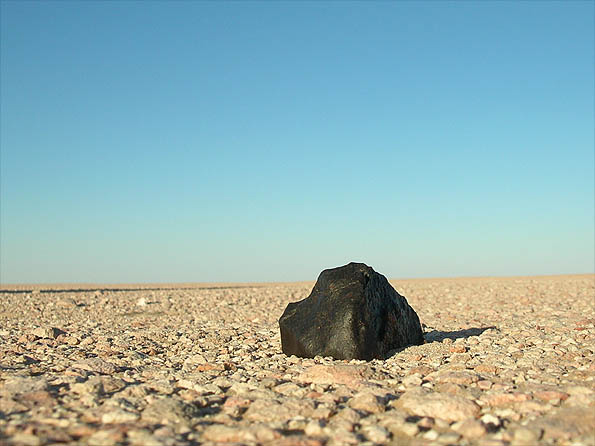How to Find a Meteorite in 5 Steps

Earth is under constant bombardment by space rocks. When they crash and burn through the atmosphere, most of the debris gets lost to the oceans, while some is buried or gradually weathered away. Nonetheless, plenty of chunks of fallen meteors, or meteorites, are strewn across the accessible parts of the planet. So far, more than 40,000 meteorites have been found and catalogued, and countless more are still out there, waiting to be chanced upon.
If you need further incentive for finding something that was forged at the birth of our sun and contains secrets about the nature of our solar system, there's this: Space rocks are worth as much as $1,000 per gram. The following tips will get you started on your search, but be warned: This extraterrestrial treasure hunt requires hard work and dedication.
Step 1. Get permission
Before you plan a meteorite hunt, make sure that if you find one, you'll be allowed to keep it. Space rocks found in national parks belong to the federal government and cannot legally be kept, said David Kring, a meteorite scientist at the University of Arizona's Lunar and Planetary Institute.
The law is ambiguous regarding ownership of meteorites found on the 264 million acres of public lands, mostly in the American West (and including many of the country's meteorite hotspots), that are managed by the Bureau of Land Management (BLM). According to Bob Verish, a meteorite recovery expert who has found hundreds of meteorites, some BLM offices consider meteorites to be artifacts, and thus regard them as government property, but the vast majority of BLM offices do not. It's a pretty safe bet that any meteorites found on public lands will be yours to keep, Verish said — "so just go ahead and meteorite hunt."
But if you don't want to take the risk of finding something that could theoretically be confiscated in the future, you're better off searching on privately owned land. Get permission to do so. "Meteorites belong to the land owner," Kring said. "Anytime a person wants to look for meteorites, arrangements with the land owner should be made first."
Step 2. Pick a good spot
Get the Space.com Newsletter
Breaking space news, the latest updates on rocket launches, skywatching events and more!
In a world full of rocks, narrowing your search is key. "Meteorites fall anywhere, but they are easiest to spot where there are few terrestrial rocks," said Alan Rubin, a geochemist at the University of California, Los Angeles, who specializes in characterizing newly discovered meteorites. [What If the Sky Actually Fell?]
The best hunting grounds are large, barren expanses where a dark rock — meteorites tend to be blackish — is easy to spot. Deserts, such as Southern California's Mojave Desert, and icy regions, such as Antarctica, are ideal. "Furthermore, the dry conditions in all of these regions (even Antarctica) help preserve the specimens — i.e., they are less altered by liquid water," Rubin told Life's Little Mysteries, a sister site of SPACE.com.
Within the Mojave or another desert, ancient, dry lake beds are ideal places to search, because their surfaces have likely been exposed for millennia. According to O. Richard Norton and Lawrence Chitwood in their book "Field Guides to Meteors and Meteorites" (Springer, 2008), many meteorites have been found in the Mojave Desert's Rosamond, Muroc and Lucerne dry lakes, among others.
You can also search in "strewn fields," or zones where meteorites from a single space rock were dispersed as it broke up during atmospheric entry. There are well-known strewn fields located near New Mexico's Glorieta Mountain, as well as Holbrook and Franconia in Arizona. Since 1995, thousands of stony meteorites have also been recovered in what appears to be two overlapping strewn fields in Gold Basin, Ariz.
Lastly, the Great Plains is an area with scant terrestrial rocks, so out-of-this-world ones come in higher proportions. "Any new rocks farmers dig up have a good chance of being meteoritic," Norton and Chitwood wrote. "Ask permission to scout the fence rows where rocks are often thrown. More than one meteorite has been found in a farmer's rock pile, or propping open a screen door."
Step 3. Search for new arrivals
Some space rock hunters aren't content to simply look for long-lost meteorites. For folks like Robert Ward, a professional meteorite hunter who last month found a piece of a meteor that was seen crashing through Earth's atmosphere above California the day before, the thrill is finding new arrivals.
Furthermore, when a newly fallen meteorite can be matched with the trajectory of the meteor that deposited it, this enables scientists to determine both its mineral content and what part of space it originated from. In the same vein as sending a space probe to an asteroid or cometand collecting a sample — but infinitely cheaper — finding a meteorite whose incoming trajectory is known can reveal fresh information about the structure and composition of a distant region of the solar system.
So, when a new fireball is spotted screeching toward Earth's surface, how do you go about finding the meteorites it deposited along its path? Bill Cooke, head of NASA's Meteoroid Environment Office, said you need to identify the ground below an incoming meteor's "dark flight" — the part of its trajectory after it slows below 3 or 4 kilometers per second, at which point it no longer burns and produces light.
"If an accurate trajectory is available, dark flight calculations are performed to figure out where pieces of various sizes may strike the ground. These calculations are posted on the Internet, usually on the meteorobs or meteorites list," Cooke wrote in an email.
Recently, Marc Fries of the Carnegie Institute of Washington developed a technique to locate falls without the need for a precise trajectory or dark flight. Fries uses Doppler weather radar to detect a "rain" of meteoritic particles falling to the ground, permitting rapid location of meteorite fall zones. It was this technique that defined the fall area for the California meteorite and led to Ward's find. Fries' blog, Radar Obs of Meteor Events, is "perhaps THE URL for a meteorite hunter to check," Cooke wrote.
Step 4. Harness the power of magnetism
When preparing for your desert hunting trip, Verish recommends packing plenty of water, snake guards and sunglasses; he also warns against going it alone, and advises meteorite hunters to ride out in two vehicles in case one breaks down.
Also, don't forget your metal detector. "Most meteorites contain at least some metallic iron-nickel and so will be at least somewhat magnetic and set off metal detectors," Rubin wrote in an email.
However, Verish said the best meteorite hunters "find them by eye." Not only can you cover more ground if you're not blindly waving a wand back and forth, but some of the more elusive and thus more remarkable types of meteorites do not contain metal, and can be discovered only by carefully scouring the ground for odd-looking rocks. "These are lunar meteorites, Martian meteorites and igneous meteorites (achondrites) derived from asteroids (essentially basalts)," Rubin wrote.
Step 5. Share with science
If you spot what you think might be a specimen from space, ask yourself these questions: Is the rock black or brown? Is it solid, without pores, and dense compared to most other rocks in the area? If a corner of the sample is ground slightly, is the interior metallic silver? (If there is no grinding, don't grind it). Is the sample magnetic? If you answered yes to all of these questions, you probably have a genuine, 4.5-billion-year-old piece of the cosmos.
Go ahead and put it on your mantle, but please take a moment to share news of your find with scientists. Though thousands of meteorites have been catalogued already, each new one is a fresh data point, and could contain a key to one of the many unanswered questions about the solar system's formation and evolution.
"Hunters can send samples in to meteorite researchers for them to be classified properly," Rubin wrote. "But there is a price for this service: researchers generally demand 20 grams or 20 percent of the total amount of a specimen (whichever is the lesser amount) for their university or museum collections in return for analysis."
Follow Natalie Wolchover on Twitter @nattyover. Follow Life's Little Mysteries on Twitter @llmysteries, then join us on Facebook.
Join our Space Forums to keep talking space on the latest missions, night sky and more! And if you have a news tip, correction or comment, let us know at: community@space.com.

Natalie Wolchover was a staff writer for Live Science and a contributor to Space.com from 2010 to 2012. She is now a senior writer and editor at Quanta Magazine, where she specializes in the physical sciences. Her writing has appeared in publications including Popular Science and Nature and has been included in The Best American Science and Nature Writing. She holds a bachelor's degree in physics from Tufts University and has studied physics at the University of California, Berkeley.










